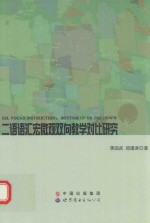图书介绍
二语词汇宏微观双向教学对比研究PDF|Epub|txt|kindle电子书版本网盘下载

- 蒋国武,郑通涛著 著
- 出版社: 北京;西安:世界图书出版公司
- ISBN:9787519209346
- 出版时间:2016
- 标注页数:180页
- 文件大小:20MB
- 文件页数:188页
- 主题词:英语-词汇-教学研究-高等学校
PDF下载
下载说明
二语词汇宏微观双向教学对比研究PDF格式电子书版下载
下载的文件为RAR压缩包。需要使用解压软件进行解压得到PDF格式图书。建议使用BT下载工具Free Download Manager进行下载,简称FDM(免费,没有广告,支持多平台)。本站资源全部打包为BT种子。所以需要使用专业的BT下载软件进行下载。如BitComet qBittorrent uTorrent等BT下载工具。迅雷目前由于本站不是热门资源。不推荐使用!后期资源热门了。安装了迅雷也可以迅雷进行下载!
(文件页数 要大于 标注页数,上中下等多册电子书除外)
注意:本站所有压缩包均有解压码: 点击下载压缩包解压工具
图书目录
Introduction1
Chapter 1:Background2
1.1 Introduction2
1.2 Statement of the Problem4
1.3 Research Objectives4
1.4 Significance of the Study5
1.5 Vocabulary Teaching in China5
1.5.1 English as a Second Language in China5
1.5.2 The Role of Vocabulary Knowledge6
1.5.3 The Current Situation of Vocabulary Teaching in China7
Chapter 2:Literature Review8
2.1 Introduction8
2.2 Approaches and Methods in Language Teaching9
2.3 Approaches to Vocabulary Teaching11
2.3.1 Incidental Approach12
2.3.2 Intentional Approach13
2.3.3 Word Association Approach and the Contextualised Approach16
2.4 Vocabulary Knowledge and Development17
2.4.1 Vocabulary Size17
2.4.2 What is Involved in Knowing a Word?19
2.4.3 Receptive Knowledge versus Productive Knowledge21
2.4.4 The Development of Vocabulary Knowledge23
2.4.5 Vocabulary Teaching and Learning Burden29
2.5 Language Processing and the Conceptualisation of Bottom-up and Top-down31
2.6 The Components of a Vocabulary Course36
2.6.1 The Goals of Vocabulary Teaching37
2.6.2 Needs Analysis of a Vocabulary Course38
2.6.3 Environment Analysis42
2.6.4 Teaching Principles42
2.6.5 Teaching Content and Sequence43
2.6.6 Format and Presentation44
2.6.7 Monitoring and Assessment46
2.6.8 Course Evaluation47
2.7 Previous Research48
2.7.1 Research on Bottom-up and Top-down Approaches48
2.7.2 Research on Vocabulary Teaching51
2.8 Chinese Culture and the Role of Culture in EFL Teaching55
2.8.1 The Fundamental Features of Chinese Culture56
2.8.2 The Role of Culture in EFL Teaching57
2.9 Summary and Implications59
Chapter 3:Methodology and Design61
3.1 Introduction61
3.2 Overview of the Research Project61
3.3 Research Design62
3.4 Participants62
3.4.1 Research Sample62
3.4.2 Recruitment63
3.4.3 Allocation of Participants64
3.5 Instruments66
3.5.1 Background Information Questionnaire67
3.5.2 Vocabulary Knowledge Tests68
3.5.3 Course Evaluation Questionnaire70
3.6 Research Procedure71
3.7 Instruction72
3.7.1 Teaching Procedure73
3.7.2 Teaching Materials and Resources75
3.7.3 Teaching Activities77
3.8 Data Analysis78
3.9 Summary80
Chapter 4:Data Analysis81
4.1 Overview81
4.2 Preliminary(Descriptive)Analysis81
4.3 Main Analysis83
4.3.1 The Results of Academic Vocabulary Size Tests(AVST)84
4.3.2 The Results of Controlled Productive Knowledge Tests(CPKT)85
4.4 Conclusion86
Chapter 5:Discussion87
5.1 Overview87
5.2 The Different Effect between Bottom-up and Top-down Approaches88
5.2.1 Nature of L2 Lexical Acquisition and its Alignment with Bottom-up Processing89
5.2.2 Learner's Low Proficiency Level Favours Bottom-up Processing90
5.2.3 Socio-cultural and Traditional Factors in the Chinese Context91
5.3 About the Vocabulary Course102
5.3.1 Composition of the Course(in terms of Nation's four strands)102
5.3.2 The Role of Explicit/Direct Vocabulary Instruction104
5.3.3 Input Processing Management105
5.3.4 The Instruction Targeted both Receptive and Productive Skills107
5.3.5 Combination of both the Key Words Approach and the Contextualised Approach109
5.3.6 Use of Online Resources110
5.4 Conclusion111
Chapter 6:Conclusion112
6.1 Project Summary112
6.2 Contribution of the Study114
6.2.1 Contributions to Scholarship in the Field of L2 Research114
6.2.2 Contributions to Second Language Pedagogy114
6.3 Limitations of the Current Study and Recommendation for Future Research115
6.4 Recommendations for Second Language Pedagogy116
6.4.1 A Plausible,Heuristic and Eclectic Approach in ELT117
6.4.2 Eclectic Dynamic Language Acquisition Model Integrating Bottom-up and Top-down Dimensions120
6.5 Final Comments124
References126
Appendix A:Teaching Syllabus137
Appendix B:Lesson Plan140
Appendix C:Teaching Materials148
1.Academic Words Lists(AWL)(Coxhead,2000)148
2.Sub-lists of the AWL(Coxhead,2000)153
3.IELTS Preparing Book(IELTS 7,2008,p.78)154
4.The List of Target Teaching Words156
5.Academic Vocabulary Exercises160
Appendix D:Teaching Resources166
1.Word Formation:http://wordinfo.info/166
2.Bilinguial online dictionary:http://www.iciba.com/166
3.WordNet Search 3.0:http://wordnetweb.princeton.edu/perl/webwn167
4.Visualthesaurus:http://www.visualthesaurus.com/trialover/168
5.Oxford Collocation Dictionary Online:http://www.ozdic.con168
6.Long Dictionary of Contemporary English:http://www.ldoceonline.com169
Appendix E:Research Instruments170
1.Background Information Collection Form170
2.Vocabulary Pre and Post Tests175
3.Course Evaluation Questionnaire179